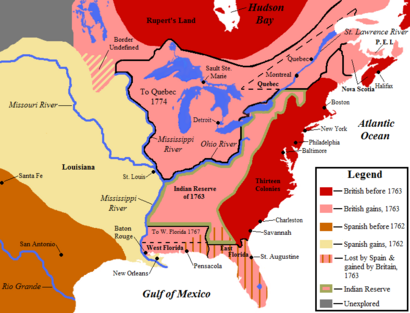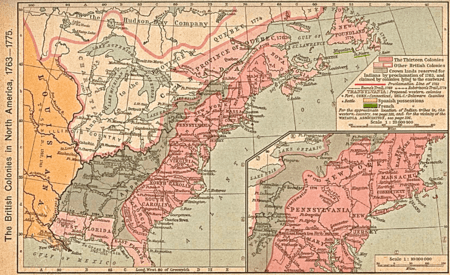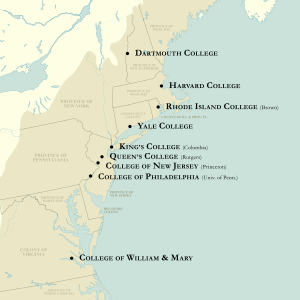Thirteen Colonies facts for kids
Quick facts for kids
The Thirteen Colonies
|
|||||||||||||||||
|---|---|---|---|---|---|---|---|---|---|---|---|---|---|---|---|---|---|
| 1607–1776 | |||||||||||||||||
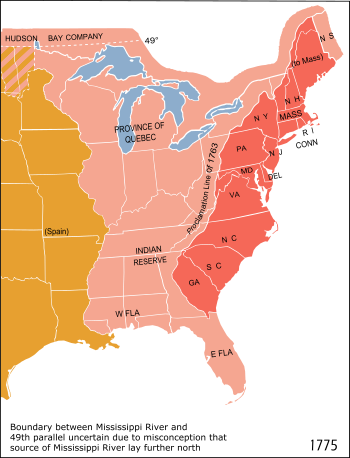
The Thirteen Colonies (shown in red) in 1775 with modern borders overlaid
|
|||||||||||||||||
| Status | Colonies | ||||||||||||||||
| Government | Various colonial arrangements | ||||||||||||||||
| Monarch | |||||||||||||||||
|
• 1607–1625
|
James I & VI (first) | ||||||||||||||||
|
• 1760–1776
|
George III (last) | ||||||||||||||||
| History | |||||||||||||||||
| 1585 | |||||||||||||||||
| 1607 | |||||||||||||||||
| 1620 | |||||||||||||||||
|
• Rhode Island Royal Charter
|
1673 | ||||||||||||||||
|
• New Netherland ceded to England
|
1667 | ||||||||||||||||
| 1713 | |||||||||||||||||
| 1732 | |||||||||||||||||
| 1754–1763 | |||||||||||||||||
| 1776 | |||||||||||||||||
| 1783 | |||||||||||||||||
| Population | |||||||||||||||||
|
• 1625
|
1,980 | ||||||||||||||||
|
• 1775
|
2,400,000 | ||||||||||||||||
|
|||||||||||||||||
The Thirteen Colonies were a group of British settlements along the Atlantic coast of North America. They were founded in the 1600s and 1700s. These colonies were very important in the history of the United States.
A movement called the American Enlightenment helped people in these colonies think about freedom. This led to the American Revolutionary War. The colonies declared their independence in July 1776. They officially became free from Britain in 1783 with the Treaty of Paris.
The Thirteen Colonies were grouped into three main areas:
- The New England Colonies: New Hampshire, Massachusetts, Rhode Island, and Connecticut.
- The Middle Colonies: New York, New Jersey, Pennsylvania, and Delaware.
- The Southern Colonies: Maryland, Virginia, North Carolina, South Carolina, and Georgia.
These colonies had similar ways of governing themselves. Most people spoke English and were Protestant. The first colony was Virginia Colony in 1607. Some colonies were started for religious freedom. Others were founded for business and to make money. The Middle Colonies were built on land that used to be a Dutch colony called New Netherland. All 13 colonies were part of Britain's lands in the New World.
The number of people in the colonies grew a lot, from about 2,000 in 1625 to 2.4 million by 1775. This growth meant that Native American lands were taken over. Sadly, slavery was legal in all colonies before the American Revolution.
In the 1700s, Britain used a policy called mercantilism. This meant the colonies were run to benefit Britain's economy. The colonies had a lot of self-governance and held local elections. They often disagreed with Britain's demands for more control. The French and Indian War (1754–1763) caused more tension. During this war, the colonies started working together. They used newspapers to share their concerns. They demanded their "Rights as Englishmen", especially "no taxation without representation". These disagreements led to the American Revolution. The colonies formed the Continental Congress and fought the American Revolutionary War (1775–1783). They had help from France, and some help from the Dutch Republic and Spain.
Contents
Fun Facts About the Colonies
- Caesar Rodney, a founding father from Delaware, rode 80 miles to sign the Declaration of Independence. He had facial cancer and kept his face covered, so we don't know what he looked like.
- In 1758, people in Windham, Connecticut, thought they were being attacked by Native Americans. But the loud sounds were just thousands of frogs fighting over their territory!
- Massachusetts had many "firsts" in America. This includes the first Thanksgiving in 1621 and the first Dunkin’ Donuts in 1950.
- During the War of 1812, people in Saint Michaels, Maryland, put lamps on ship masts and tree tops. This tricked the British into thinking the town was higher up. Only one house was hit by cannon fire.
- In 1948, Mahlon Haines built a house shaped like a shoe in Hillam, Pennsylvania. It had three bedrooms and two bathrooms. He let elderly couples stay there. Now, it's an ice cream shop!
- The arm of Stonewall Jackson is buried about 150 miles away from the rest of his body in Virginia.
- Many colonies were named after English royalty.
- Georgia was the last of the thirteen colonies to be formed. It was a safe place for poor people who owed money.
How the British Colonies Started

Dark Red = New England colonies.
Bright Red = Middle Atlantic colonies.
Red-brown = Southern colonies.
In 1606, King James I of England gave permission to two companies to start settlements in America. The London Company started the Colony of Virginia in 1607. This was the first lasting English colony on the continent. The Plymouth Company tried to start the Popham Colony, but it didn't last long.
Later, the Plymouth Council helped start other colonies. One important one was Plymouth Colony in 1620. It was settled by English Puritans, known as the Pilgrims. Other countries like the Dutch, Swedish, and French also started colonies. But these eventually became part of the English lands. The last of the Thirteen Colonies, Province of Georgia, was founded in 1732. The name "Thirteen Colonies" became popular during the American Revolution.
From 1660, all colonies were managed by a government department in London. In 1768, a special department for America was created.
New England Colonies
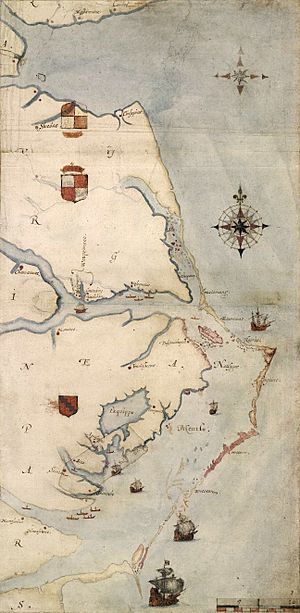
- Province of Massachusetts Bay: Became a royal colony in 1691.
- Popham Colony: Started in 1607, but abandoned in 1608.
- Plymouth Colony: Started in 1620, joined with Massachusetts Bay Colony in 1691.
- Province of Maine: Started in 1622, later joined Massachusetts Bay Colony.
- Massachusetts Bay Colony: Started in 1628, joined with Plymouth Colony in 1691.
- Province of New Hampshire: Started in 1629, became a royal colony in 1679.
- Connecticut Colony: Started in 1636, became a royal colony in 1662.
- Saybrook Colony: Started in 1635, joined Connecticut Colony in 1644.
- New Haven Colony: Started in 1638, joined Connecticut Colony in 1664.
- Colony of Rhode Island and Providence Plantations: Became a royal colony in 1663.
- Providence Plantations: Started by Roger Williams in 1636.
- Portsmouth: Started in 1638.
- Newport: Started in 1639.
- Warwick: Started in 1642.
- These four settlements joined to form one royal colony in 1663.
Some New England colonies formed the New England Confederation in 1643. Later, all New England colonies were part of the Dominion of New England (1686–1689).
Middle Colonies
- Delaware Colony: Started in 1664 as a proprietary colony (owned by a person or family).
- Province of New York: Started as a proprietary colony in 1664, became a royal colony in 1686.
- Province of New Jersey: Started as a proprietary colony in 1664, became a royal colony in 1702.
- East Jersey: Started in 1674, joined with West Jersey to form New Jersey in 1702.
- West Jersey: Started in 1674, joined with East Jersey to form New Jersey in 1702.
- Province of Pennsylvania: Started in 1681 as a proprietary colony.
Southern Colonies
- Colony of Virginia: Started in 1607 as a proprietary colony, became a royal colony in 1624.
- Province of Maryland: Started in 1632 as a proprietary colony.
- Province of North Carolina: Was part of the Carolina province until 1712, became a royal colony in 1729.
- Province of South Carolina: Was part of the Carolina province until 1712, became a royal colony in 1729.
- Province of Georgia: Started as a proprietary colony in 1732, became a royal colony from 1752.
The Province of Carolina was first planned in 1629. Settlements began after 1651. The king later gave a new charter in 1663, making it a proprietary colony. The Carolina province was split into North and South Carolina in 1712.
Before these, the Roanoke Colony was started in 1585. It was re-established in 1587, but then found empty in 1590.
The 1600s in the Colonies
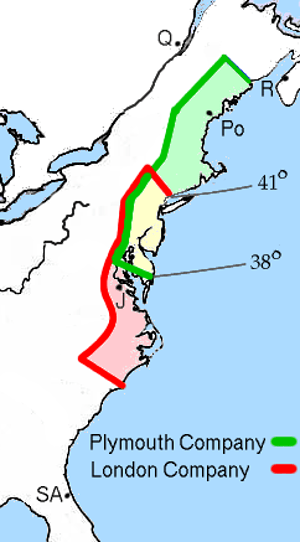
Southern Colonies in the 1600s
The first successful English colony was Jamestown. It was founded on May 14, 1607, near Chesapeake Bay. The London Virginia Company paid for it, hoping to find gold. The first years were very hard. Many people died from sickness and hunger. There were also wars with local Native Americans. But the colony survived by growing tobacco, which became a valuable crop.
In 1632, King Charles I gave the charter for the Province of Maryland to Cecil Calvert, 2nd Baron Baltimore. Calvert's father was a Catholic official who wanted Catholics to move to the English colonies. The charter did not say anything about religion.
The Province of Carolina was the second attempt to settle south of Virginia. It was a private project, paid for by a group of English nobles. They got a Royal Charter for the Carolinas in 1663. They hoped it would be profitable like Jamestown. Carolina was not settled until 1670. The first try failed because people didn't want to move there. Eventually, the nobles funded a new settlement led by Sir John Colleton. This group found good land at Charleston.
Middle Colonies in the 1600s
Starting in 1609, Dutch traders set up fur trading posts. They were on the Hudson River, Delaware River, and Connecticut River. They wanted to protect their fur trade business. The Dutch West India Company built lasting settlements on the Hudson River. This created the Dutch colony of New Netherland. In 1626, Peter Minuit bought the island of Manhattan from the Lenape Indians. He set up the outpost of New Amsterdam.
Not many Dutch people settled in New Netherland. But the colony became very important for fur trade in the area. It also traded a lot with the English colonies. Many goods from New England and Virginia went to Europe on Dutch ships. The Dutch also took part in the Atlantic slave trade. They brought some enslaved Africans to the English colonies. However, many more went to places like Barbados and Brazil. The West India Company wanted New Netherland to grow. But it didn't attract as many settlers as the English colonies. Many who did move there were English, German, Walloon, or Sephardic Jews.
In 1638, Sweden started the colony of New Sweden in the Delaware Valley. Former members of the Dutch West India Company, including Peter Minuit, led this effort. New Sweden traded a lot with English colonies to the south. It shipped much of the tobacco grown in Virginia. The Dutch took over this colony in 1655.
In the 1650s, the English and Dutch fought several wars. The English wanted to conquer New Netherland. Richard Nicolls easily captured New Amsterdam in 1664. His men quickly took the rest of New Netherland. The 1667 Treaty of Breda ended the Second Anglo-Dutch War. It confirmed that England controlled the region. The Dutch briefly got back parts of New Netherland in the Third Anglo-Dutch War. But they gave up their claim to the land in the 1674 Treaty of Westminster. This ended the Dutch colonies in America.
The British renamed New Amsterdam to "York City" or "New York". Many Dutch people stayed in the colony. They were mostly in the countryside between Manhattan and Albany. People from New England and Germany also started moving in. New York City attracted many different kinds of people. This included a large population of enslaved Black people. In 1674, the proprietary colonies of East Jersey and West Jersey were created from land that was once part of New York.
Pennsylvania was founded in 1681. It was a proprietary colony owned by a Quaker named William Penn. The main groups of people included Quakers in Philadelphia. There were also Scotch-Irish people on the western frontier. Many German communities were in between. Philadelphia became the largest city in the colonies. It had a good location, an excellent port, and about 30,000 people.
New England in the 1600s
The Pilgrims were a small group of Puritans. They wanted to separate from the Church of England, which they felt was corrupt. They first moved to the Netherlands. But in 1620, they sailed to America on the Mayflower. When they arrived, they wrote the Mayflower Compact. This document bound them together as a community. It helped them establish the small Plymouth Colony. William Bradford was their main leader. After Plymouth was founded, more settlers came from England.
More Puritans came in 1629 and started the Massachusetts Bay Colony with 400 settlers. They wanted to improve the Church of England. They aimed to create a new, pure church in the New World. By 1640, 20,000 Puritans had arrived. Many died soon after arriving. But others found a healthy climate and plenty of food. The Plymouth and Massachusetts Bay colonies led to other Puritan colonies in New England. These included New Haven, Saybrook, and Connecticut. During the 1600s, New Haven and Saybrook joined Connecticut.
Roger Williams started Providence Plantations in 1636. He got the land from Narragansett leader Canonicus. Williams was a Puritan who believed in religious tolerance. He also believed in the separation of Church and State. He wanted a complete break from the Church of England. He was banned from the Massachusetts Bay Colony because of his beliefs. He founded his settlement based on equal rights. It had majority rule in civil matters and freedom of religion. In 1637, another group, including Anne Hutchinson, started a second settlement. It was on Rhode Island, now called Aquidneck. Samuel Gorton and others started a settlement near Providence Plantations. They called it Shawomet. But Massachusetts Bay tried to take the land. So Gorton went to London to get a charter from the King. Robert Rich, 2nd Earl of Warwick helped him get the charter. Gorton then changed the settlement's name to Warwick. Roger Williams got a Royal Charter from the King in 1663. This charter united all four settlements into the Colony of Rhode Island and Providence Plantations.
Other colonists settled to the north. They mixed with adventurers and people looking to make money. This led to more religiously diverse colonies in New Hampshire and Maine. Massachusetts took over these small settlements in the 1640s and 1650s. But New Hampshire eventually got its own charter in 1679. Maine remained part of Massachusetts until it became a state in 1820.
In 1685, King James II of England closed the colonial legislatures. He combined the New England colonies into the Dominion of New England. This put the region under the control of Governor Edmund Andros. In 1688, New York, West Jersey, and East Jersey were added to the dominion. Andros was removed from power, and the dominion was closed in 1689. This happened after the Glorious Revolution removed King James II. The former colonies were then re-established.
The 1700s in the Colonies
In 1702, East and West Jersey combined to form the Province of New Jersey.
The northern and southern parts of the Carolina colony worked mostly on their own. But in 1691, Philip Ludwell was made governor of the whole province. From then until 1708, the northern and southern settlements had one government. However, during this time, the two halves became known as North Carolina and South Carolina. The owners of the colony argued about how to run it. The colonists in Charles Town finally removed their governor. They elected their own government. This led to separate governments in the Province of North-Carolina and the Province of South Carolina. In 1729, the king officially took back Carolina's colonial charter. He made both North Carolina and South Carolina royal colonies.
In the 1730s, a politician named James Oglethorpe suggested settling the area south of the Carolinas. He wanted to send England's "worthy poor" there. This would give them an alternative to crowded debtors' prisons. Oglethorpe and other English helpers got a royal charter for the colony of Georgia on June 9, 1732. Oglethorpe hoped to create a perfect colony that banned slavery. He wanted to recruit only the best settlers. But by 1750, the colony still had few people. The owners gave up their charter in 1752. At that point, Georgia became a royal colony.
The number of people in the Thirteen Colonies grew greatly in the 1700s. By 1750, the population was 1.5 million. This was four-fifths of all people in British North America. More than 90 percent of colonists were farmers. But some port cities also grew. In 1760, Philadelphia, New York, and Boston each had over 16,000 people. By 1770, the Thirteen Colonies produced 40 percent of the entire British Empire's economic output.
As the 1700s went on, colonists began to settle far from the Atlantic coast. Pennsylvania, Virginia, Connecticut, and Maryland all claimed land in the Ohio River valley. The colonies rushed to buy land from Native American tribes. The British said that land claims had to be based on real purchases. Virginia especially wanted to expand west. Most wealthy Virginia families invested in the Ohio Company. This company promoted settlement in the Ohio Country.
Trade and New People
The British American colonies became part of Britain's worldwide trading system. The value of goods sent from America to Britain tripled between 1700 and 1754. Colonists were limited in trading with other European countries. But they found good trade partners in other British colonies, especially in the Caribbean. The colonists traded food, wood, tobacco, and other resources. In return, they got Asian tea, West Indian coffee, and sugar. Native Americans far from the coast supplied beaver fur and deerskins. America had many natural resources. It also built its own successful shipbuilding industry. Many American merchants took part in trade across the Atlantic Ocean.
Better economic conditions and less religious persecution in Europe made it harder to find workers for the colonies. So, many colonies relied more on enslaved labor, especially in the South. The number of enslaved people in America grew a lot between 1680 and 1750. This growth came from forced immigration and slaves having children. Enslaved people worked on large plantations in the South. In the North, enslaved people worked in many different jobs. There were some slave revolts, like the Stono Rebellion and the New York Conspiracy of 1741. But these uprisings were stopped.
Few English people moved to America after 1700. But the colonies attracted new immigrants from other European countries. These immigrants went to all colonies. But the Middle Colonies attracted the most and remained more diverse. Many settlers came from Ireland, both Catholic and Protestant. Many Protestant Germans also came, especially to Pennsylvania. In the 1740s, the Thirteen Colonies experienced the First Great Awakening. This was a time of religious revival.
The French and Indian War
In 1738, an event involving a sailor named Robert Jenkins started a war between Britain and Spain. It was called the War of Jenkins' Ear. Hundreds of North Americans volunteered to fight in Admiral Edward Vernon's attack on Cartagena de Indias, a Spanish city. This war became part of a bigger conflict called the War of the Austrian Succession. But most colonists called it King George's War. In 1745, British and colonial forces captured the town of Louisbourg. The war ended with the 1748 Treaty of Aix-la-Chapelle. But many colonists were angry when Britain gave Louisbourg back to France. This was in exchange for Madras and other lands. After the war, both the British and French wanted to expand into the Ohio River valley.
The French and Indian War (1754–1763) was the American part of the Seven Years' War in Europe. Earlier wars in North America started in Europe and then spread to the colonies. But the French and Indian War started in North America and then spread to Europe. A main cause was the growing competition between Britain and France. This was especially true in the Great Lakes and Ohio valley.
The French and Indian War became very important for the British North American colonists. William Pitt the Elder decided to send many soldiers to North America. He wanted to win the war against France. For the first time, North America became a main part of a "world war". During the war, American colonists realized they were under the British Empire's authority. British military and government officials became more present in their lives.
The war also made Americans feel more united. Men traveled across the continent who might never have left their own colony. They fought alongside men from different backgrounds who were still American. British officers trained Americans for battle. George Washington was one of them. This helped the American cause during the Revolution. Also, colonial governments had to work closely together for the war effort. Relations were not always good between the British military and the colonists. This set the stage for later distrust of British troops. At the 1754 Albany Congress, Benjamin Franklin suggested the Albany Plan. This plan would have created a united government for the Thirteen Colonies. It was for defense and other matters. But the leaders of most colonies rejected the plan.
In the Treaty of Paris (1763), France officially gave Britain the eastern part of its North American empire. France had secretly given the land west of the Mississippi River to Spain the year before. Before the war, Britain had the thirteen American colonies, most of Nova Scotia, and most of the Hudson Bay area. After the war, Britain gained all French land east of the Mississippi River. This included Quebec, the Great Lakes, and the Ohio River valley. Britain also gained Spanish Florida. From this, it formed the colonies of East and West Florida. By removing a major foreign threat, the war also made the colonists feel less need for British protection.
The British and colonists won together against a common enemy. The colonists' loyalty to Britain was stronger than ever. However, disagreements began to form. British Prime Minister William Pitt the Elder decided to fight the war using colonial troops and British tax money. This was a successful war plan. But after the war, each side felt it had done more than the other. The wealthy British, who paid high taxes, were angry that the colonists paid little to the king. The colonists replied that their sons had fought and died in a war that helped Europe more than themselves. This argument was one of the reasons that soon led to the American Revolution.
Growing Disagreements
Britain had large debts after the French and Indian War. So British leaders decided to increase taxes and control over the Thirteen Colonies. They put in place several new taxes. These started with the Sugar Act of 1764. Later acts included the Currency Act of 1764, the Stamp Act of 1765, and the Townshend Acts of 1767. Colonial newspapers and printers especially disliked the Stamp Act. It taxed newspapers and official documents. They played a big role in spreading ideas against these taxes. They also argued against the idea of "taxation without colonial representation".
The Royal Proclamation of 1763 stopped settlement west of the Appalachian Mountains. This area was set aside as an Indian Reserve. Some settlers ignored the proclamation and continued to move west. The proclamation was soon changed and no longer stopped settlement. But colonists were angry that it was made without asking them first.
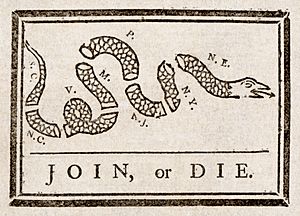
The British Parliament directly taxed the colonies. They did this without asking the colonial governments. Americans then started to demand "no taxation without representation". They strongly protested the Stamp Act of 1765. They argued that the colonies had no representatives in the British Parliament. So, taxing them was against their rights as Englishmen. Parliament ignored the protests and passed new taxes.
Colonial anger grew with the 1773 Tea Act. This act lowered taxes on tea sold by the East India Company. It was meant to make British tea cheaper than smuggled tea. Prime Minister North hoped this would make colonists accept British taxes. But trouble grew over the tea tax. Americans in each colony boycotted the tea. In Boston, the Sons of Liberty dumped thousands of pounds of tea into the harbor during the Boston Tea Party in 1773. Tensions increased in 1774. Parliament passed laws known as the Intolerable Acts. These laws greatly limited self-government in Massachusetts. They also allowed British military leaders to take over colonial homes for soldiers. This happened whether the American civilians agreed or not. The laws also took away the right for colonists to have trials in cases involving soldiers. Such trials had to be held in England. Parliament also sent Thomas Gage to be Governor of Massachusetts. He was also the commander of British forces in North America.
By 1774, colonists still hoped to stay part of the British Empire. But there was widespread unhappiness with British rule. Colonists chose delegates for the First Continental Congress. It met in Philadelphia in September 1774. After the Intolerable Acts, the delegates said the colonies only owed loyalty to the king. They would accept royal governors as the king's agents. But they would no longer accept Parliament's right to make laws for the colonies. Most delegates did not want to attack the British in Boston. Instead, the Continental Congress agreed to a boycott called the Continental Association. The boycott worked well, and British imports dropped a lot. The Thirteen Colonies became more divided. Some were Patriots who opposed British rule. Others were Loyalists who supported it.
The American Revolution
In response, the colonies formed elected groups called Provincial Congresses. Colonists started to boycott British goods. Later in 1774, 12 colonies sent representatives to the First Continental Congress in Philadelphia. During the Second Continental Congress, Georgia also sent delegates.
Massachusetts Governor Thomas Gage worried about a fight with the colonists. He asked Britain for more soldiers. But the British government did not want to pay for many soldiers in the Thirteen Colonies. Instead, Gage was told to seize Patriot weapons. He sent soldiers to Concord, Massachusetts. But the Patriots found out and stopped them. The Patriots fought back the British at the April 1775 Battles of Lexington and Concord. Then they surrounded Boston.
By spring 1775, all British officials had been removed. The Continental Congress held a meeting of delegates from the 13 colonies. It created an army to fight the British. George Washington was named its commander. The Congress made treaties, declared independence, and told the colonies to write constitutions and become states. The Second Continental Congress met in May 1775. It began to organize armed resistance against Britain. It set up a government that recruited soldiers and printed its own money. General Washington took command of the Patriot soldiers in New England. He forced the British to leave Boston. In 1776, the Thirteen Colonies (now called states) declared their independence from Britain. With help from France and Spain, they defeated the British and their German allies in the American Revolutionary War. The final battle was the Siege of Yorktown in 1781. In the Treaty of Paris (1783), Britain officially recognized the United States of America as independent.
Colonial Population Growth
| Year | Estimated Population |
|---|---|
| 1610 | 350 |
| 1620 | 2,302 |
| 1630 | 4,246 |
| 1640 | 25,734 |
| 1650 | 49,368 |
| 1660 | 75,058 |
| 1670 | 111,935 |
| 1680 | 151,507 |
| 1690 | 210,372 |
| 1700 | 250,588 |
| 1710 | 331,711 |
| 1720 | 466,185 |
| 1730 | 629,445 |
| 1740 | 905,563 |
| 1750 | 1,170,760 |
| 1760 | 1,593,625 |
| 1770 | 2,148,076 |
The number of people in the colonies grew to a quarter of a million during the 1600s. It reached almost 2.5 million just before the American Revolution. These numbers do not include Native American tribes outside the colonies' control.
Good health was important for the colonies' growth. Fewer deaths among young people meant more people reached adulthood. This helped the colonies grow quickly. There were also other reasons for population growth, like the Great Migration.
By 1776, about 85% of the white population had ancestors from the British Isles. This includes English, Scots-Irish, Scottish, and Welsh people. About 9% were of German origin. 4% were Dutch, and 2% were French Huguenots or other groups. Over 90% of people were farmers. There were also several small cities that were seaports. These cities connected the colonial economy to the larger British Empire. These populations continued to grow fast in the late 1700s and early 1800s. This was mainly because of high birth rates and low death rates. Immigration was a small factor from 1774 to 1830.
Here's a look at the different groups of people in the British American Colonies:
| Ethnic composition in the British American Colonies of 1700, 1755, 1775 | |||||
|---|---|---|---|---|---|
| 1700 | Percent | 1755 | Percent | 1775 | Percent |
| English and Welsh | 80.0% | English and Welsh | 52.0% | English | 48.7% |
| African | 11.0% | African | 20.0% | African | 20.0% |
| Dutch | 4.0% | German | 7.0% | Scots-Irish | 7.8% |
| Scottish | 3.0% | Scots-Irish | 7.0% | German | 6.9% |
| Other European | 2.0% | Irish | 5.0% | Scottish | 6.6% |
| Scottish | 4.0% | Dutch | 2.7% | ||
| Dutch | 3.0% | French | 1.4% | ||
| Other European | 2.0% | Swedish | 0.6% | ||
| Colonies | 100% | Colonies | 100% | Thirteen Colonies | 100% |
Slavery in the Colonies
Slavery was legal in all Thirteen Colonies. In most places, enslaved people worked as house servants or farm workers. Slavery was very important for the economy in Virginia and Maryland. There, enslaved people worked on tobacco farms. In South Carolina, they worked on rice and indigo farms. About 287,000 enslaved people were brought to the Thirteen Colonies over 160 years. This was about 2% of the estimated 12 million people taken from Africa to the Americas through the Atlantic slave trade. Most enslaved people went to sugar colonies in the Caribbean and to Brazil. There, life expectancy was short, and new enslaved people were constantly needed. By the mid-1700s, life expectancy was much higher in the American colonies.
| 1620–1700 | 1701–1760 | 1761–1770 | 1771–1780 | Total |
|---|---|---|---|---|
| 21,000 | 189,000 | 63,000 | 15,000 | 288,000 |
The number of enslaved people grew quickly due to high birth rates and low death rates. By the 1860 census, there were nearly four million enslaved people. From 1770 to 1860, the natural growth rate of enslaved people in North America was much faster than in any European country. It was almost twice as fast as in England.
Religion in the Colonies
Most people in the Thirteen Colonies were Protestant. But there were also Catholics, Jews, and deists. Many people had no religious connection. The Church of England was the official church in most of the South. The Puritan movement became the Congregational church. It was the official religion in Massachusetts and Connecticut into the 1700s. This meant that tax money went to church expenses. The Anglican churches in the South were controlled by local groups. They also had public duties, like fixing roads and helping the poor.
The colonies had many different religions. Different Protestant groups came from Britain, Germany, the Netherlands, and other places. The Reformed tradition was the basis for Presbyterian, Congregationalist, and Continental Reformed churches. French Huguenots started their own Reformed churches. The Dutch Reformed Church was strong among Dutch Americans in New York and New Jersey. Lutheranism was common among German immigrants. Germans also brought different forms of Anabaptism, especially the Mennonite kind. Reformed Baptist preacher Roger Williams founded Providence Plantations. This became the Colony of Rhode Island and Providence Plantations. Jews lived mostly in a few port cities. The Baltimore family founded Maryland and brought other Catholics from England. In 1775, about 1.6% of the population, or 40,000 people, were Catholic. Most Catholics were English, German, Irish, or Black. Half lived in Maryland, with many also in New York and Pennsylvania. Presbyterians were mainly immigrants from Scotland and Ulster. They preferred living in the frontier areas.
Quakers were well established in Pennsylvania. They controlled the government there for many years. Quakers were also numerous in Rhode Island. Baptists and Methodists grew quickly during the First Great Awakening in the 1740s. Many religious groups sent missionaries to local Native American tribes.
Education in the Colonies
Higher education was available for young men in the north. Most students wanted to become Protestant ministers. Nine colleges were started during the colonial era. These colleges, known as the colonial colleges, were:
- New College (Harvard)
- College of William & Mary
- Yale College (Yale)
- College of New Jersey (Princeton)
- King's College (Columbia)
- College of Philadelphia (University of Pennsylvania)
- College of Rhode Island (Brown)
- Queen's College (Rutgers)
- Dartmouth College
The College of William & Mary and Queen's College later became public schools. The others are now seven of the eight private Ivy League universities.
Except for the College of William and Mary, these colleges were all in New England and the Middle Colonies. The southern colonies believed that families were responsible for educating their children. This was a common belief in Europe. Wealthy families either hired tutors from Britain or sent their children to school in England. By the 1700s, college students in the colonies also started working as tutors.
Most New England towns had public schools for boys. But public schooling was rare elsewhere. Girls were taught at home or in small local private schools. They could not go to college. Young people wanting to become doctors or lawyers usually learned by working with an experienced professional. Some young men went to medical schools in Scotland.
Colonial Government
In 1776, there were three types of colonial governments:
- Provincial (royal colony)
- Proprietary (owned by a person or family)
- Charter (given special rights by the king)
All these governments were under the British monarch. They had no representatives in the Parliament of Great Britain. The Board of Trade in London oversaw all British colonies starting in the late 1600s.
A provincial colony was governed by people chosen by the king. The king appointed a governor and his council. The governor had general executive powers. He could also call a local assembly elected by the people. The governor's council acted as an upper house when the assembly met. It also advised the governor. Assemblies were made up of representatives elected by landowners. The governor could stop laws and delay or end the assembly. The assembly's job was to make local laws. These laws had to be consistent with British laws. But in reality, assemblies often tried to gain more power. Laws could be reviewed by the British Privy Council or Board of Trade. These groups also had the power to veto laws. New Hampshire, New York, Virginia, North Carolina, South Carolina, and Georgia were royal colonies. Massachusetts became a royal colony in the late 1600s.
Proprietary colonies were governed much like royal colonies. But the lord proprietors (owners) appointed the governor, not the king. These colonies were set up after the English Restoration of 1660. They usually had more civil and religious freedom. Pennsylvania (which included Delaware), New Jersey, and Maryland were proprietary colonies.
Charter governments were like political companies created by royal documents. These documents gave the owners control of the land and the power to make laws. The charters provided a basic constitution. They divided powers among lawmaking, executive, and judicial roles. These powers were given to officials. Massachusetts, Providence Plantation, Rhode Island, Warwick, and Connecticut were charter colonies. The Massachusetts charter was taken away in 1684. It was replaced by a provincial charter in 1691. Providence Plantations joined with settlements at Rhode Island and Warwick. This formed the Colony of Rhode Island and Providence Plantations. It also became a charter colony in 1636.
Britain's Role
After 1680, the British government in London became more interested in the colonies. The colonies were growing fast in population and wealth. In 1680, only Virginia was a royal colony. By 1720, half of them were controlled by royal governors. These governors were chosen by and closely connected to the government in London.
Colonial Politics
Settlers did not come to America planning to create a democracy. But they quickly created a system where many people could vote. The 13 colonies had no noble families like in Europe. There were no rich landowners who owned all the farms and rented them out. Instead, there was a system of local control. It was run by men elected in fair elections. The colonies allowed more people to vote than Britain or any other country. Any property owner could vote for members of the lower house of the legislature. Governors were appointed in London. But in Connecticut and Rhode Island, colonists elected their governor. Women, children, indentured servants, and enslaved people could not vote. Native Americans and free Black people were usually outside the political system and could not vote. Voters had to own property. In most places, good farmland was cheap and widely owned. So, 50% to 80% of men could vote.
Historian Donald Radcliffe noted:
The right to vote had always been extraordinarily widespread—at least among adult white males--even before the country gained its independence....Enfranchisement varied greatly by location. There certainly were communities, particularly newly settled communities where land was inexpensive, in which 70 or 80 percent of all white men were enfranchised. Yet there were also locales...where the percentages were far lower, closer to 40 or 50 percent....On the whole, the franchise was far more widespread than it was in England, yet as the revolution approached, the rate of property ownership was falling, and the proportion of adult white males who were eligible to vote was probably less than 60 percent.
Colonial politics valued respect for local leaders. These leaders were the ones who ran for office and were chosen. But sometimes they competed and had to ask common people for votes. There were no political parties. People who wanted to be lawmakers formed temporary groups of family, friends, and neighbors. Election day brought all the men from the countryside to the county seat or town center. They would celebrate, talk politics, shake hands with important people, meet old friends, and listen to speeches. All this happened while they were toasting, eating, and gambling. They voted by shouting their choice to the clerk, as supporters cheered or booed. In Virginia, candidate George Washington spent money on treats for his supporters. Candidates knew they had to "swill the planters with bumbo" (rum). Elections were like carnivals where all men were equal for one day.
Voting was not required. Usually, about half of the men who could vote actually voted. Turnout was often higher in Pennsylvania and New York. There, long-standing groups based on ethnic and religious backgrounds encouraged more supporters to vote. New York and Rhode Island developed two-group systems that lasted for years at the colony level. But these groups did not affect local matters. The groups were based on the personalities of a few leaders and family connections. They had little to do with policies or ideas. Elsewhere, politics changed often. It was based on personalities rather than lasting groups or serious disagreements.
The colonies were independent of each other before 1774. Each colony started as a separate settlement. Efforts to form a colonial union, like the Albany Congress of 1754 led by Benjamin Franklin, had failed. All thirteen colonies had strong systems of self-government and elections. These were based on the Rights of Englishmen. They were determined to protect these rights from British interference.
Economic Rules
The British Empire at the time used a system called mercantilism. This meant all trade had to stay within the Empire. Trading with other empires was forbidden. The goal was to make Britain rich—its merchants and its government. Whether this policy was good for the colonists was not a concern in London. But Americans became increasingly unhappy with mercantilist policies.
Mercantilism meant that the government and merchants worked together. Their goal was to increase political power and private wealth. They wanted to keep other empires out. The government protected its merchants. It kept others out with trade barriers, rules, and money for British industries. This was to maximize exports from Britain and minimize imports. The government had to fight smuggling. This became a favorite American way to get around rules on trading with the French, Spanish, or Dutch in the 1700s. Mercantilism aimed to have more exports than imports. This way, gold and silver would flow into London. The government took its share through duties and taxes. The rest went to merchants in Britain. The government spent much of its money on a great Royal Navy. This navy protected British colonies and threatened others. Sometimes it even captured them. For example, the British Navy captured New Amsterdam (New York) in 1664. The colonies were forced to buy British goods. The goal was to make the mother country rich. Colonial goods were shipped on British ships to Britain. Britain then sold them to Europe, making money from the export trade. Finished goods were made in Britain and sold in the colonies. Or they were imported by Britain for sale to the colonies. This also profited Britain. Like other New World empires, Britain's production of goods depended on enslaved labor. In the 1720s, people in Britain noted that "all this great increase in our treasure proceeds chiefly from the labour of negroes" in Britain's colonies.
Britain enforced mercantilism by trying to stop American trade with French, Spanish, or Dutch empires. They used the Navigation Acts. Americans avoided these acts as often as they could. Royal officials responded to smuggling with open-ended search warrants (Writs of Assistance). In 1761, Boston lawyer James Otis argued that these warrants violated the colonists' constitutional rights. He lost the case. But John Adams later wrote, "Then and there the child Independence was born."
However, the colonists were careful to say that they did not oppose British rules on their trade with other countries. They only opposed laws that affected them internally.
Other British Colonies in North America
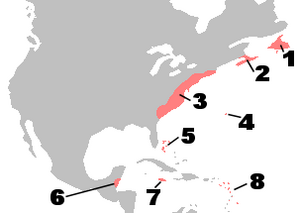
- Newfoundland
- Nova Scotia
- Thirteen Colonies
- Bermuda
- Bahamas
- British Honduras
- Jamaica
- British Leeward Islands and Barbados
Besides the Thirteen Colonies, Britain had about a dozen other colonies in the New World in the late 1700s. These included:
- The British West Indies
- Newfoundland
- The Province of Quebec
- Nova Scotia
- Prince Edward Island
- Bermuda
- East and West Florida
These colonies stayed loyal to Britain during the war. (Though Spain got Florida back before the war ended, and later sold it to the United States in 1821). Some other colonies felt sympathy for the Patriot cause. But they were too far away or British naval power was too strong for them to help. Britain had only recently gained some of these lands. Many issues facing the Thirteen Colonies did not apply to them, especially Quebec and Florida.
- Rupert's Land was sparsely settled. King Charles II of England had called it "one of our Plantations or Colonies in America" in 1670. It was far from the rebellious colonies and had little in common with them.
- Newfoundland was not affected by the Navigation Acts. It had none of the complaints of the mainland colonies. It was closely tied to Britain and controlled by the Royal Navy. It had no assembly to voice complaints.
- Nova Scotia (which included modern-day New Brunswick) had many people who had recently moved from New England. They shared the same feelings as Americans in the 13 colonies about the rights of British men. The royal government in Halifax reluctantly allowed Nova Scotia to be "neutral". Also, its island-like geography and the large British naval base at Halifax made armed resistance impossible. Though American militia did try some attacks in the St. John River area.
- Quebec was home to French Catholic settlers. They came under British control by 1760. The Quebec Act of 1774 gave French settlers cultural freedom within the British Empire. Many of their Catholic priests feared the strong Protestantism in New England. American complaints about taxes were not very important to them. There was no assembly or elections to voice any complaints. In 1775, the Americans invaded Quebec to take it by force. But they were defeated by British troops and Canadien militia. After failing to get Quebec by military action, the Americans offered to include Quebec in their new country in 1777. Most Canadians stayed neutral, but some joined the American cause.
- In the West Indies, the elected assemblies of Jamaica, Grenada, and Barbados formally supported the American cause. They called for a peaceful solution. But the other islands were very loyal. Britain was careful not to anger the rich sugar plantation owners (many of whom lived in London). In turn, the planters relied more on slavery. This made them see the need for British military protection from possible slave revolts. The Royal Navy's strong presence in the islands greatly limited any open action. During the war, there was some trading with American ships when opportunities arose.
- In Bermuda and the Bahamas, local leaders were angry about food shortages. These were caused by the British blockade of American ports. There was growing sympathy for the American cause. This included smuggling. Both colonies were seen as "passive allies" of the United States during the war. When an American naval group arrived in the Bahamas to seize gunpowder, the colony offered no resistance.
- Spain had given East Florida and West Florida to Britain in the Treaty of Paris in 1763. This happened after the French and Indian War. The few British colonists there needed protection from Native American attacks and Spanish privateers. After 1775, East Florida became a major base for the British war effort in the South. This was especially true for invasions of Georgia and South Carolina. However, Spain captured Pensacola in West Florida in 1781. Spain then got back both territories in the Treaty of Paris that ended the war in 1783. Spain eventually agreed to give the Florida provinces to the United States in 1819.
|
See also
 In Spanish: Trece Colonias para niños American Revolutionary War § Prelude to revolution
In Spanish: Trece Colonias para niños American Revolutionary War § Prelude to revolution





